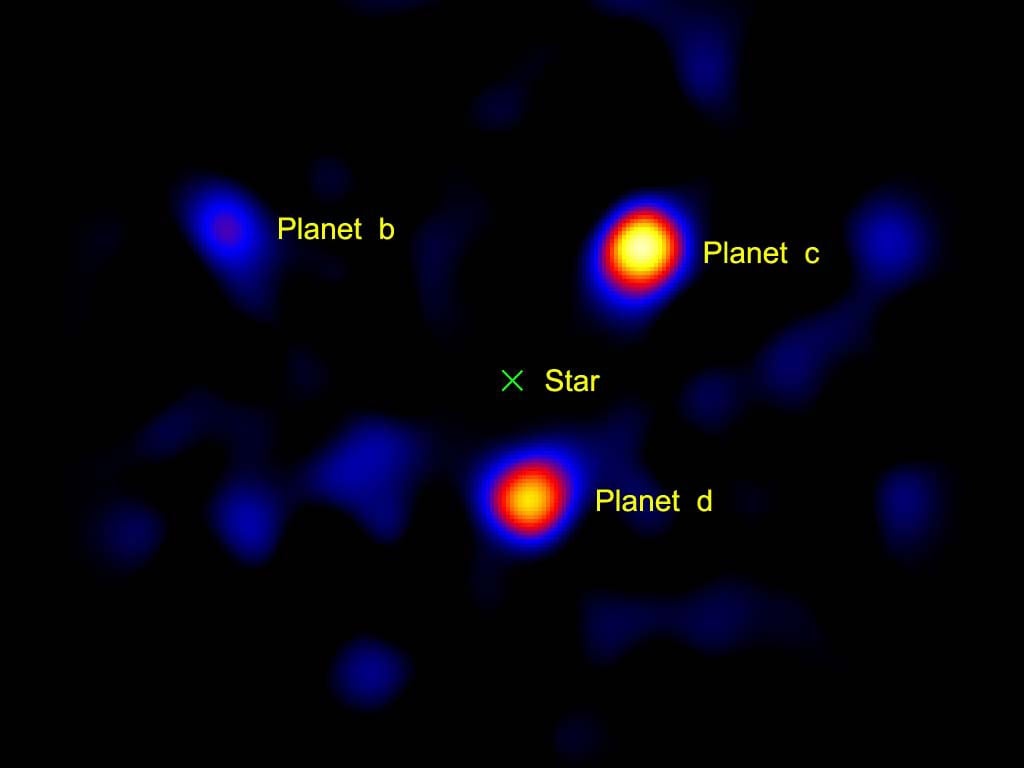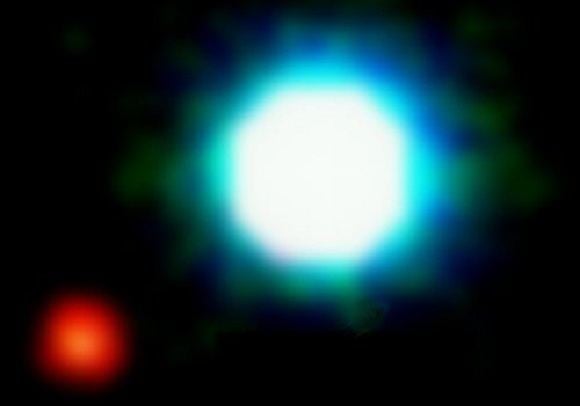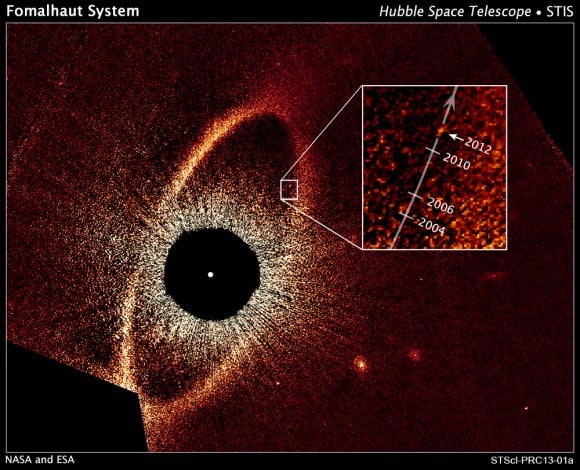Welcome back to the latest installment in our series on Exoplanet-hunting methods. Today we begin with the very difficult, but very promising method known as Direct Imaging.
In the past few decades, the number of planets discovered beyond our Solar System has grown by leaps and bounds. As of October 4th, 2018, a total of 3,869 exoplanets have been confirmed in 2,887 planetary systems, with 638 systems hosting multiple planets. Unfortunately, due to the limitations astronomers have been forced to contend with, the vast majority of these have been detected using indirect methods.
So far, only a handful of planets have been discovered by being imaged as they orbited their stars (aka. Direct Imaging). While challenging compared to indirect methods, this method is the most promising when it comes to characterizing the atmospheres of exoplanets. So far, 100 planets have been confirmed in 82 planetary systems using this method, and many more are expected to be found in the near future.
Description:
As the name would suggest, Direct Imaging consists of capturing images of exoplanets directly, which is possible by searching for the light reflected from a planet's atmosphere at infrared wavelengths. The reason for this is because at infrared wavelengths, a star is only likely to be about 1 million times brighter than a planet reflecting light, rather than a billion times (which is typically the case at visual wavelengths).
https://exoplanets.nasa.gov/5_ways_content/vid/direct_imaging.mp4
Advantages:
One of the most obvious advantages of Direct Imaging is that it is less prone to false positives. Whereas the Transit Method is prone to false positives in up to 40% of cases involving a single planet system (necessitating follow-up observations), planets detected using the Radial Velocity Method require confirmation (hence why it is usually paired with the Transit Method). In contrast, Direct Imaging allows astronomers to actually see the planets they are searching for.
While opportunities for using this method are rare, wherever direct detections can be made, it can provide scientists with valuable information on planet. For example, by examining the spectra reflected from a planet's atmosphere, astronomers are able to obtain vital information about its composition. This information is intrinsic to exoplanet characterization and determining if it is potentially habitable.
In the case of Fomalhaut b, this method allowed astronomers to learn more about the planet's interaction with the star's protoplanetary disk, place constraints on the planet's mass, and confirm the presence of a massive ring system. In the case of HR 8799, the amount of infrared radiation reflected from its exoplanet's atmosphere (combined with models of planetary formation) provided a rough estimate of the planet's mass.
Direct Imaging works best for planets that have wide orbits and are particularly massive (such as gas giants). It is also very useful for detecting planets that are positioned "face-on", meaning that they do not transit in front of the star relative to the observer. This makes it complimentary to radial velocity, which is most effective for detecting planets that are "edge-on", where planets make transits of their star.
Disadvantages:
Compared to other methods, Direct Imaging is rather difficult because of the obscuring effect light from a star has. In other words, it is very difficult to detect the light being reflected from a planet's atmosphere when its parent star is so much brighter. As a result, opportunities for Direct Imaging are very rare using current technology.
For the most part, planets can only be detected using this method when they orbit at great distances from their stars or are particularly massive. This makes it very limited when it comes to searching for terrestrial (aka. "Earth-like") planets that orbit closer to their stars (i.e. within their star's habitable zone). As a result, this method is not particularly useful when it comes to searching for potentially-habitable exoplanets.
Examples of Direct Imaging Surveys:
The first exoplanet detection made using this technique occurred in July of 2004, when a group of astronomers used the European Southern Observatory's (ESO) Very Large Telescope Array (VLTA) to image a planet several times the mass of Jupiter in close proximity to 2M1207 - a brown dwarf located about 200 light years from Earth.
In 2005, further observations confirmed this exoplanet's orbit around 2M1207. However, some have remained skeptical that this was the first case of "Direct Imaging", since the low luminosity of the brown dwarf was what made the detection of the planet possible. In addition, because it orbits a brown dwarf has led some to argue that the gas giant is not a proper planet.
In September of 2008, an object was imaged with a separation of 330 AU around its host star, 1RXS J160929.1-210524 - which is located 470 light-years away in the Scorpius constellation. However, it was not until 2010 that it was confirmed to be a planet and a companion to the star.
On November 13th, 2008, a team of astronomers announced that they captured images of an exoplanet orbiting the star Fomalhaut using the Hubble Space Telescope. The discovery was made possible thanks to the thick disk of gas and dust surrounding Fomalhaut, and the sharp inner edge which suggests that a planet had cleared debris out of its path.
Follow-up observations with Hubble produced images of the disk, which allowed astronomers to locate the planet. Another contributing factor is the fact that this planet, which is twice the mass of Jupiter, is surrounded by a ring system that is several times thicker than Saturn's rings, which caused the planet to glow quite brightly in visual light.
On the same day, astronomers using the telescopes from both the Keck Observatory and Gemini Observatory announced that they had imaged 3 planets orbiting HR 8799. These planets, which have masses 10, 10, and 7 times that of Jupiter, were all detected in infrared wavelengths. This was attributed to the fact that HR 8799 is a young star and the planets around it are thought to still retain some of the heat of their formation.
In 2009, analysis of images dating back to 2003 revealed the existence of a planet orbiting Beta Pictoris. In 2012, astronomers using the Subaru Telescope at the Mauna Kea Observatory announced the imaging of a "Super-Jupiter" (with 12.8 Jupiter masses) orbiting the star Kappa Andromedae at a distance of about 55 AU (nearly twice the distance of Neptune from the Sun).
Other candidates have been found over the years, but so far, they remain unconfirmed as planets and could be brown dwarfs. In total, 100 exoplanets have been confirmed using the Direct Imaging method (roughly 0.3% of all confirmed exoplanets), and the vast majority were gas giants that orbited at great distances from their stars.
However, this is expected to change in the near future as next-generation telescopes and other technologies become available. These include ground-based telescopes equipped with adaptive optics, such as the Thirty Meter Telescope (TMT) and the Giant Magellan Telescope (GMT). They also include telescopes that rely on coronographs (like the James Webb Space Telescope (JWST), where a device inside the telescope is used to block light from a star.
Another method that is being developed is known as a 'starshade', a device that's positioned to block light from a star before it even enters a telescope. For a space-based telescope looking for exoplanets, a starshade would be a separate spacecraft, designed to position itself at just the right distance and angle to block starlight from the star astronomers were observing.
We have many interesting articles about exoplanet-hunting here at Universe Today. Here's What is the Transit Method?, What is the Radial Velocity Method?, What is the Gravitational Microlensing Method?, and Kepler’s Universe: More Planets in our Galaxy than Stars.
Astronomy Cast also has some interesting episodes on the subject. Here's Episode 367: Spitzer does Exoplanets and Episode 512: Direct Imaging of Exoplanets.
For more information, be sure to check out NASA's page on Exoplanet Exploration, the Planetary Society's page on Extrasolar Planets, and the NASA/Caltech Exoplanet Archive.
Sources:
- *NASA - Five Ways to Find an Exoplanet: Direct Imagining*
- Wikipedia - Methods of Exoplanet Detection: Direct Imaging
- The Planetary Society - Direct Imaging
- Las Cumbres Observatory - Direct Imaging
 Universe Today
Universe Today


